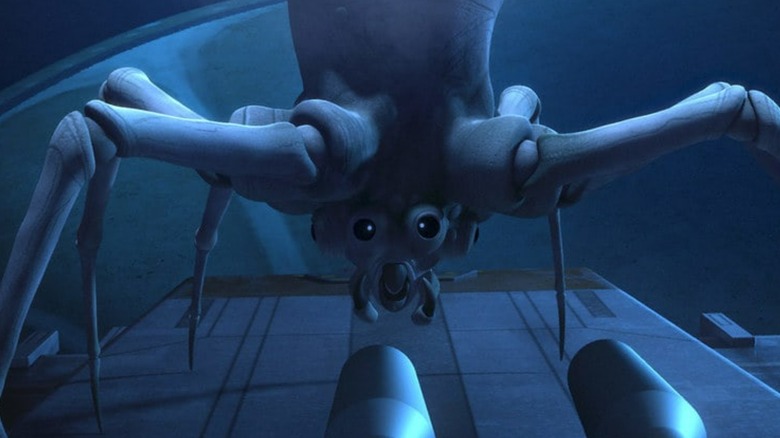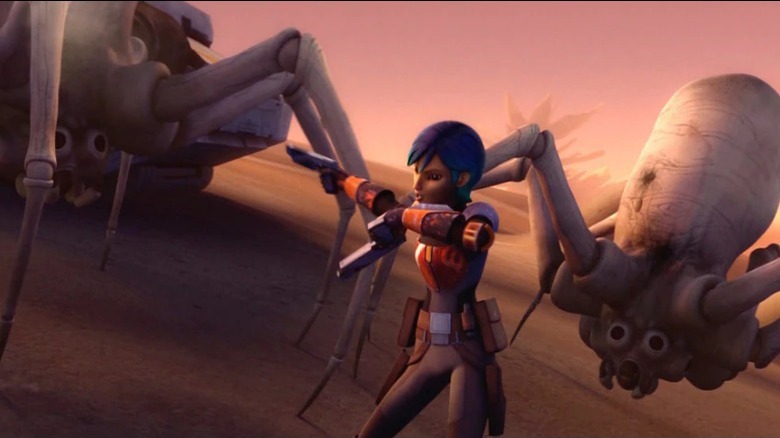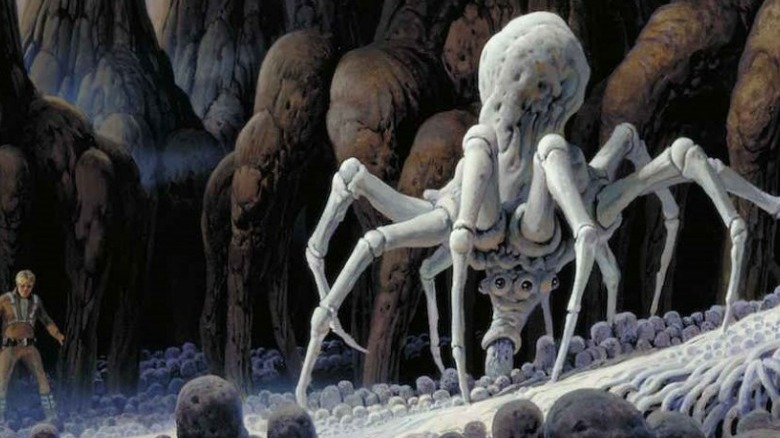The Krykna In Star Wars Explained
When "Star Wars" debuted at the cinema way back in 1977, few could have predicted just how massive it would become. It quickly became a merchandising juggernaut, spawned cinematic sequel after cinematic sequel, and introduced fans to a host of books, comics, and video games. At the same time, the canon the original film introduced rapidly expanded in all directions, amounting to one of the most sprawling universes in all of pop culture. It's jam-packed with unique worlds, cultures unlike anything on Earth, and, of course, no shortage of alien inhabitants.
From the moment the "Star Wars" saga began, fans fell in love with its many non-human beings regardless of how much screen time they received. Some were fuzzy, lovable heroes like Chewbacca the Wookiee (Peter Mayhew), while others, such as the Trandoshan bounty hunter Bossk (Alan Harris), were far more menacing and evil. Nevertheless, one can't help but appreciate the time and dedication that it took to bring these other-worldly creatures to life, even if some were downright difficult to look at. Case in point, the Krykna: the fictional bane of arachnophobes everywhere.
Though they haven't done much in the grand scheme of "Star Wars" history, there's a lot more to the Krykna than their brief appearances have divulged. Here's a crash course on these dangerous, unsettling creatures.
Krykna are a galactic nuisance
At the time of this writing, the Krykna have made only a small handful of appearances in "Star Wars" canon. Their grand introduction came via the beloved animated series "Star Wars Rebels," specifically during its second season. They gave the ragtag band of heroes quite the scare in "The Mystery of Chopper Base," entrapping their ship, the Ghost, in webs and capturing Rex (Dee Bradley Baker) and Dicer (Ashley Eckstein).
The Krykna would pop up on "Rebels" a few more times throughout Season 3. Their appearances in "Zero Hour," "Trials of the Darksaber," and "Warhead" are rather uneventful, but they prove important to Ezra Bridger's (Taylor Gray) Jedi training in "The Holocrons of Fate." Kanan Jarrus (Freddie Prinze Jr.) uses their presence as a teaching tool to instill in his young padawan the value of maintaining one's emotions and resolving conflicts peacefully.
It's worth pointing out that similar spider-like creatures appear in "The Mandalorian" Season 2 episode "The Passenger," but they're not Krykna. The things that attack Din Djarin (Pedro Pascal) and Grogu on Maldo Kreis are actually known as knobby white ice spiders — almost certainly a close relative to the Atollon-native Krykna.
The Krykna are rooted in the original Star Wars trilogy
Regardless of their official name, Krykna and creatures like them are hardly a new concept in the "Star Wars" universe. In fact, such horrifying entities date back to the time of the original trilogy, courtesy of the late, great concept artist Ralph McQuarrie. He came up with the design for a creature known as the knobby white spider in 1979, as seen above, which would appear on Dagobah during Luke Skywalker's (Mark Hamill) Jedi training in "Star Wars: Episode V – The Empire Strikes Back."
Ultimately, the knobby white spider didn't immediately make it from art to screen — a common fate for many of McQuarrie's ideas. Thankfully, he didn't waste his time at the art desk since it and many of his other unused works snuck their way into "Star Wars" media long after his death in 2012. For instance, locations like Lothal and the Sith temple on Malachor, as well as characters like Zeb Orellios (Steve Blum) and Chopper (Dave Filoni), owe their presentation in ways big and small to McQuarrie's decades-old yet timeless art (via Den of Geek).
All in all, the Krykna and their monstrous relatives exist primarily to send a shiver up our spines. That aside, they represent the formative years of "Star Wars" and one of the most important people to contribute to the franchise's stunning aesthetic. For those reasons, they're welcome additions to the galaxy far, far away.


